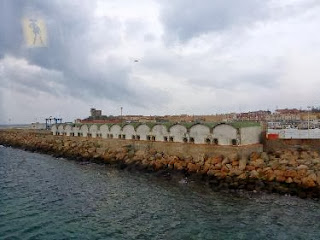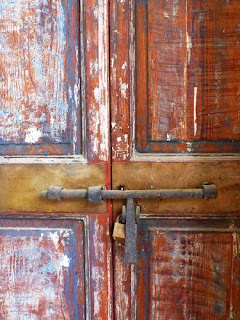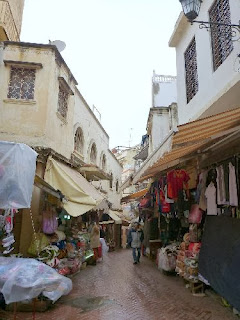Day 16 began with a crack of dawn start. Actually it was before the crack of dawn but that didn't stop the mad Spanish rooster from mournfully crowing in the day. Perry (on what's app) said it couldn't be a Spanish rooster because if he was he would know that you don't get up till 10am.
Johnny drove brilliantly through the dark unlit country roads, even correcting the miss advice from the navigator who wanted to take us on a longer route to Tarifa port. When we arrived we parked on the dock and with as little formality as possible went through passport control and on to the ferry. It was a massive craft, made in Tasmania and registered in Limassol. The trip over was very smooth and with the aid of a travacalm pill I nodded off to sleep.
The sky was overcast as we pulled into Tangier and some showers were expected but we'd arrived prepared with rain jackets. True to his word Ahmed met us on the dock and has a taxi waiting to take us on a tour of the ritzy end of the city. Up on the hills, rich westerners and emirati had built palaces for them and their friends to drop into when in town. From here it was a short drive to the coastal road to see where the Atlantic and Mediterranean seas met. There was a lot of new development along this strip but local conservationists had ensured that the bask of local vegetation were left undisturbed and that the buildings were low profile rather than towers. As with Southern Spain, the beaches were vast and with deep yellow sand. A boy and his two donkeys hopefully approached us looking for a handout or the price of a donkey ride. The hills were covered with low growing umbrella pines, which Ahmed told us are the only ones that grow pine nuts.
Ahmed took us to Hercules caves. An ancient community of several hundred people lived in the caves gouged out of the local rock. The ceiling and walls of the caves were marked by the semicircular cuts they had made into the stone. They cut grain grinding stones, which they shaped and traded across the region for other items they needed. Every now and then a great wave would rush into the cave and splatter us with foam.
We then drove back to town where we parted ways with the taxi driver and walked with Ahmed through the Kasbah. Ahmed is the president of the local tourist association and throughout the day all sorts of people dashed over to shake his hand and say hello. At one stage the minister for tourism stopped in the street to shake hands with him. Though we were warned that the city might be full of bothersome beggars and people hassling us to buy things, there was none of that.
Ahmed took us to key gates in the city and pointed out the various architectural styles. On one side of one gate were the catholic Spanish houses with their outward looking balconies. On the other side of the gate were the dilapidated looking but inward looking Arabic houses. Ahmed said that once you enter these houses they are quite palatial. He explained that the Muslim religion values what is inside rather than a gaudy show.
In the Kasbah we visited the anthropology museum. This had room devoted to the various groups of people who inhabited the area over the years. While there were interesting exhibits so much more could have been done and Ahmed bemoaned the fact that huge amounts of money are spent by the culture and tourism ministry on brining in dancers and singers but that so little money is spent to collect and display the antiquities that the area is rich in. The pirates that robbed local ships of treasure that used to pull into the coast, bury the treasure and mark the spot by planting long living carob trees. Much of this treasure was not retrieved and later people thought that the carob trees marked a sacred site. They built walls around them and protected them from interference. This of course meant that the antiquities remain buried beneath them.
Johnny and I were hanging out for a coffee and cake but Ahmed made us wait till every last bit of his archeological knowledge had been dispensed to us. By this time it was raining but Ahmed knew a good coffee shop and we sheltered under the the awnings. The shop owner sent a boy into a back street to bring back some cakes. We had a lovely break, taking in the theatre of the street which included a fishmonger selling from a cart, three wheeled motorcycle trucks wheeling through the traffic and a cigarette seller (who bought cigarettes from the tobacconist stall and then sold them individually to "light smokers" who only wanted one or two). As a service to the public (and an enticement to passers by to stop), he also had for the use of thirsty passers by, a blue cup and quantity of water. Johnny and I passed up the offer.
The old city outside the Kasbah was the Medina. Beyond these two areas, everything else was built after 1923. We walked through the Medina and if possible, these laneways were even more narrow than the Spanish lanes. There were so many one man shops, each with a tumble of merchandise crammed into a space as small as Johnny's study. The market was full of organic produce, which Ahmed trusts more than the supermarket. The olive stalls were amazing. Great mounds of olives, stuffed, picked, and in all sizes and shapes smiled at me temptingly. The butcher shops had great mounds of cow on a slab, ready to be hacked off to the customer's order. No one seemed to worry at being photographed which was wonderful. Actually only one woman declined. She was a Berber woman wearing the traditional jelapi and hat, selling her home produced rounds of cheese.
We promised Brit that we would try to get her a T shirt from Cinema Rif. Ahmed found it for us but is was locked up tight. Sorry Brit. This was at the top end of a plaza that draws crowds in the evening and with its position between the Kasbah, the Medina and with the construction of a new fountain, you can see it being a popular place.
Ahmed also took us on a tour of St. Andrews, an Anglican Church built in a hybrid Anglo and moorish style. It has the Lord's Prayer inscribed in Arabic, around the altar. A lovely young man who acted as caretaker toured us around the church and the surrounding cemetery.
Ahmed must have had a bigger breakfast than us because it looked like he had no intention of stopping for lunch. I asked if we could grab something to eat and as per usual he knew someone who would see us right. He took us to a friend of his who runs a massive warehouse that sold authentic carpets, silver and brassware as well as ceramics (yes, hold on I'm getting to the food bit). We met Mohammed and while we chatted about his business, rugs and various other things, he sent his son off to a trusted cafe to bring back some delicious mint tea and " chicken and meat sandwiches" . These turned out to be a delicious charcoaly chicken and beef baguette. Ahmed went off to pray and we ate. When we finished, Mohammed and his sons put on a carpet show where they unfurled a number of rugs and explained their construction and quality. Ahmed also took us to the rooftop of Mohammed's multi-storey building for an amazing view across the Tangier rooftops.
We had heard Ahmed's introduction to Tangir's culture, religions, geography and politics. We'd heard about his views on parenting, refugees and political corruption. It had been a good day and we wanted to go home. We has been walking since 9 and it was now 5 and we were tired. Ahmed walked us back to the ferry terminal and like a mother duck, watched us proceed through passport control and back on to our ferry for the return journey. After a smooth crossing we landed in Tarifa and raced to a supermeercat for supplies. Dinner was salmon, olives, cheese selection, baguette and Rioja. Nice. off to Ronda by car tomorrow.




































































































































































